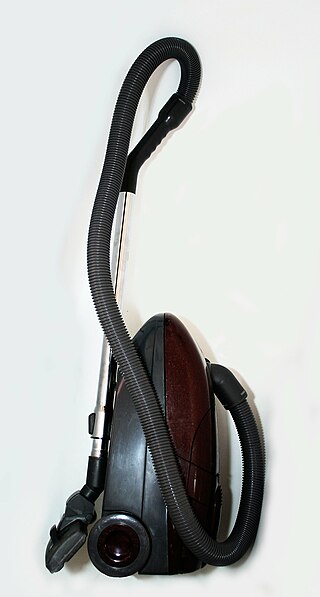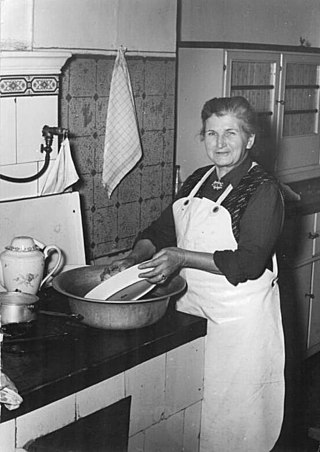
Acrylic paint is a fast-drying paint made of pigment suspended in acrylic polymer emulsion and plasticizers, silicone oils, defoamers, stabilizers, or metal soaps. Most acrylic paints are water-based, but become water-resistant when dry. Depending on how much the paint is diluted with water, or modified with acrylic gels, mediums, or pastes, the finished acrylic painting can resemble a watercolor, a gouache, or an oil painting, or have its own unique characteristics not attainable with other media.

A vacuum cleaner, also known simply as a vacuum or a hoover, is a device that causes suction in order to remove dirt from floors, upholstery, draperies, and other surfaces. It is generally electrically driven.

A dishwasher is a machine that is used to clean dishware, cookware, and cutlery automatically. Unlike manual dishwashing, which relies on physical scrubbing to remove soiling, the mechanical dishwasher cleans by spraying hot water, typically between 45 and 75 °C, at the dishes, with lower temperatures of water used for delicate items.

A laundry symbol, also called a care symbol, is a pictogram indicating the manufacturer's suggestions as to methods of washing, drying, dry-cleaning and ironing clothing. Such symbols are written on labels, known as care labels or care tags, attached to clothing to indicate how a particular item should best be cleaned. While there are internationally recognized standards for the care labels and pictograms, their exact use and form differ by region. In some standards, pictograms coexist with or are complemented by written instructions.

Dry cleaning is any cleaning process for clothing and textiles using a solvent other than water.

Sewerage is the infrastructure that conveys sewage or surface runoff using sewers. It encompasses components such as receiving drains, manholes, pumping stations, storm overflows, and screening chambers of the combined sewer or sanitary sewer. Sewerage ends at the entry to a sewage treatment plant or at the point of discharge into the environment. It is the system of pipes, chambers, manholes, etc. that conveys the sewage or storm water.

A hygrometer is an instrument which measures the humidity of air or some other gas: that is, how much water vapor it contains. Humidity measurement instruments usually rely on measurements of some other quantities such as temperature, pressure, mass and mechanical or electrical changes in a substance as moisture is absorbed. By calibration and calculation, these measured quantities can lead to a measurement of humidity. Modern electronic devices use the temperature of condensation, or they sense changes in electrical capacitance or resistance to measure humidity differences. A crude hygrometer was invented by Leonardo da Vinci in 1480. Major leaps came forward during the 1600s; Francesco Folli invented a more practical version of the device, while Robert Hooke improved a number of meteorological devices including the hygrometer. A more modern version was created by Swiss polymath Johann Heinrich Lambert in 1755. Later, in the year 1783, Swiss physicist and Geologist Horace Bénédict de Saussure invented the first hygrometer using human hair to measure humidity.
A clothes dryer, also known as tumble dryer or simply dryer, is a powered household appliance that is used to remove moisture from a load of clothing, bedding and other textiles, usually after they are washed in a washing machine.

Dishwashing, washing the dishes, doing the dishes, or washing up in Great Britain, is the process of cleaning cooking utensils, dishes, cutlery and other items to prevent foodborne illness. This is either achieved by hand in a sink using dishwashing detergent or by using a dishwasher and may take place in a kitchen, utility room, scullery or elsewhere.

Superheated steam is steam at a temperature higher than its vaporization point at the absolute pressure where the temperature is measured.

A mop is a mass or bundle of coarse strings or yarn, etc., or a piece of cloth, sponge or other absorbent material, attached to a pole or stick. It is used to soak up liquid, for cleaning floors and other surfaces, to mop up dust, or for other cleaning purposes.
The term cleanser refers to a product that cleans or removes dirt or other substances. A cleanser could be a detergent, and there are many types of cleansers that are produced with a specific objective or focus. For instance, a degreaser or carburetor cleanser used in automotive mechanics for cleaning certain engine and car parts.

A humidifier is a household appliance or device designed to increase the moisture level in the air within a room or an enclosed space. It achieves this by emitting water vapor or steam into the surrounding air, thereby raising the humidity levels.

An electric shaver is a razor with an electrically powered rotating or oscillating blade. The electric shaver usually does not require the use of shaving cream, soap, or water. The razor may be powered by a small DC motor, which is either powered by batteries or mains electricity. Many modern ones are powered using rechargeable batteries. Alternatively, an electro-mechanical oscillator driven by an AC-energized solenoid may be used. Some very early mechanical shavers had no electric motor and had to be powered by hand, for example by pulling a cord to drive a flywheel.

Coffee production is the industrial process of converting the raw fruit of the coffee plant into the finished coffee. The coffee cherry has the fruit or pulp removed leaving the seed or bean which is then dried. While all green coffee is processed, the method that is used varies and can have a significant effect on the flavor of roasted and brewed coffee. Coffee production is a major source of income for 12.5 million households, most in developing countries.

Wet cleaning refers to methods of professional cleaning that, in contrast to traditional dry cleaning, avoids the use of chemical solvents, the most common of which is tetrachloroethylene. Environmental groups and the United States Environmental Protection Agency (EPA) have indicated that such alternative "wet cleaning" methods are better for the environment than perc, and proponents of wet cleaning state that these methods can be used without shrinking or otherwise damaging garments that typically require dry cleaning.
Scrubber systems are a diverse group of air pollution control devices that can be used to remove some particulates and/or gases from industrial exhaust streams. An early application of a carbon dioxide scrubber was in the submarine the Ictíneo I, in 1859; a role for which they continue to be used today. Traditionally, the term "scrubber" has referred to pollution control devices that use liquid to wash unwanted pollutants from a gas stream. Recently, the term has also been used to describe systems that inject a dry reagent or slurry into a dirty exhaust stream to "wash out" acid gases. Scrubbers are one of the primary devices that control gaseous emissions, especially acid gases. Scrubbers can also be used for heat recovery from hot gases by flue-gas condensation. They are also used for the high flows in solar, PV, or LED processes.

Carpet cleaning is performed to remove stains, dirt, and allergens from carpets. Common methods include hot water extraction, dry-cleaning, and vacuuming.
Personal care products are consumer products which are applied on various external parts of the body such as skin, hair, nails, lips, external genital and anal areas, as well as teeth and mucous membrane of the oral cavity, in order to make them clean, protect them from harmful germs and keep them in good condition. They promote personal hygiene and overall health, well-being and appearance of those body parts. Toiletries form a narrower category of personal care products which are used for basic hygiene and cleanliness as a part of a daily routine. Cosmetic products, in contrast, are used for personal grooming and beautification. Pharmaceutical products are not considered personal care products.

The conservation and restoration of photographic plates is caring for and maintaining photographic plates to preserve their materials and content. It covers the necessary measures that can be taken by conservators, curators, collection managers, and other professionals to conserve the material unique to photographic plate processes. This practice includes understanding the composition and agents of deterioration of photographic plates, as well as the preventive conservation and interventive conservation measures that can be taken to increase their longevity.
















